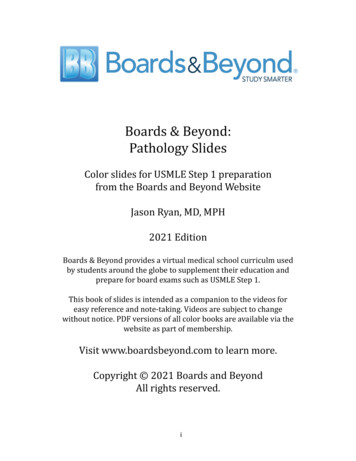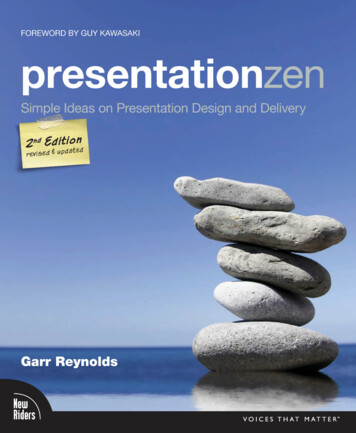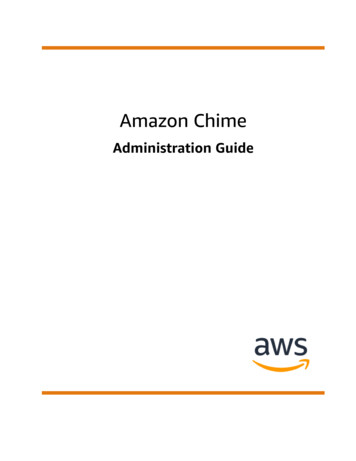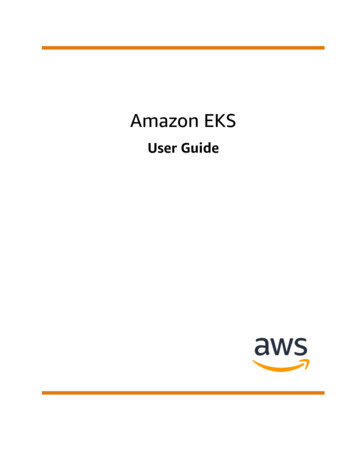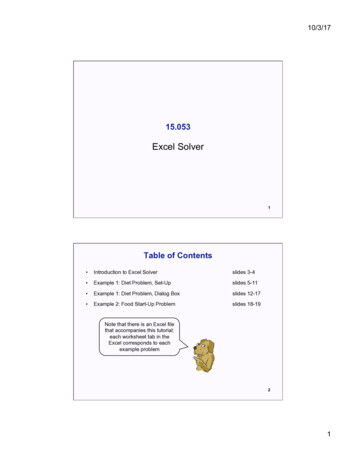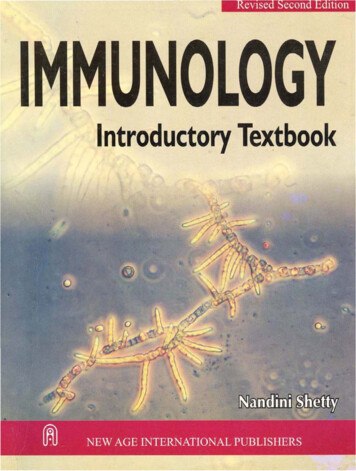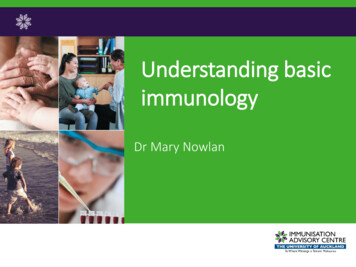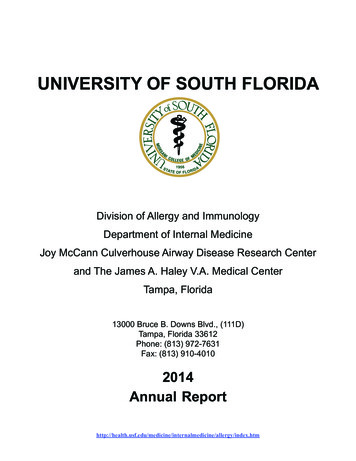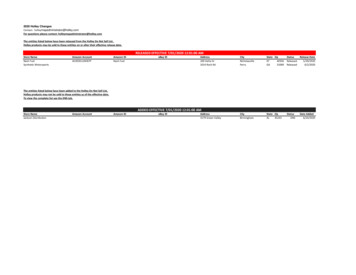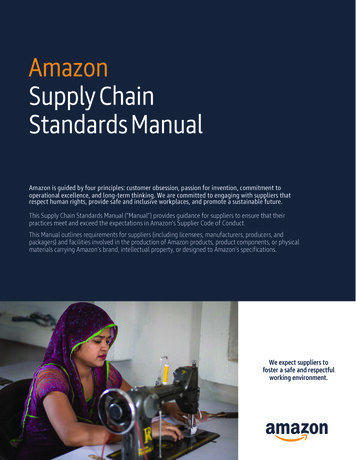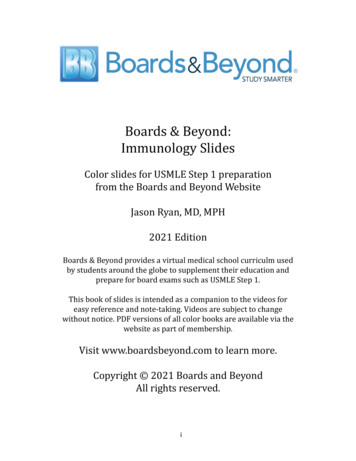
Transcription
Boards & Beyond:Immunology SlidesColor slides for USMLE Step 1 preparationfrom the Boards and Beyond WebsiteJason Ryan, MD, MPH2021 EditionBoards & Beyond provides a virtual medical school curriculm usedby students around the globe to supplement their education andprepare for board exams such as USMLE Step 1.This book of slides is intended as a companion to the videos foreasy reference and note-taking. Videos are subject to changewithout notice. PDF versions of all color books are available via thewebsite as part of membership.Visit www.boardsbeyond.com to learn more.Copyright 2021 Boards and BeyondAll rights reserved.i
ii
Table of ContentsInnate Immunity .1T-cells .9B-cells . 16Complement . 23Lymph Nodes & Spleen . 28Hypersensitivity . 32Transplants . 37Immune Deficiency Syndromes . 41Glucocorticoids and NSAIDs . 49Immunosuppressants . 52Systemic Lupus Erythematosus . 57Rheumatoid Arthritis . 61Scleroderma . 66Sjogren’s Syndrome . 69Vasculitis . 72iii
iv
Innate ImmunityBarriers to InfectionInnate ImmunityJason Ryan, MD, MPHImmune SystemsInnate Fast-acting system Non-specific reaction Same cells, same reactionto many invaders No memory 2nd infection sameresponse as 1st infectionConnexions/WikipediaSkin/MucousMembranes Innate system can be activated by “free” antigenAdaptive Pathogenic molecules detected freely in blood, tissue Slow-acting (days) Highly specific Adaptive system requires “antigen presentation” Pathogens must be engulfed by cells, broken down Pieces of protein transported to surface Antigen “presented” to T-cells for activation Unique cells activated torespond to a singleinvader Memory 2nd infection: fasterresponseCluster of Differentiation (CD) Cellular surface moleculesCell signaling proteinsOften released by immune cellsStimulate inflammatory responseVarious subsets AdaptiveImmuneSystemAntigen PresentationCytokines InnateImmuneSystem CD3, CD4, CD8 Found on many immune cells (T-cells, B-cells) Used to identify cell types Some used as receptor/cell bindingChemokine: Attracts immune cells (chemotaxis)Interleukins: IL-1, IL,2, etcTumor necrosis factor (TNF): Can cause tumor deathTransforming growth factor (TGF)Interferons: Named for interfering with viral replication1
Innate ImmunityInnate Immune SystemGeneral Principles Phagocytes Recognize molecules that are “foreign” “Pathogen-associated molecular patterns” (PAMPs) Macrophages (hallmark cell) Neutrophils Present on many microbes Not present on human cellsComplementNatural Killer CellsEosinophilsMast cells and Basophils Pattern recognition receptors Key receptor class: “Toll-like receptors” (TLRs) Macrophages, dendritic cells, mast cells Recognize PAMPs secrete cytokinesInnate ImmunityInnate ImmunityPattern RecognitionPattern Recognition Endotoxin (LPS) Mannose (polysaccharide on bacteria/yeast) Mannose-binding lectin (MBL) from liver Activates lectin pathway of complement activationLPS binds LPS-binding protein (found in plasma)Binds CD14 on MacrophagesTriggers TLR4Cytokine production: IL-1, IL-6, IL-8, TNF Lipoteichoic acid on Gram-positive bacteria Double stranded RNA Unmethylated DNA Peptidoglycan cell wall NOD receptors (intracellular) Nucleotide-binding oligomerization domain Cytokine expressionMonocytes and Macrophages Monocytes and Macrophages Three key functions:Macrophages: guardians of innate immunityProduced in bone marrow as monocytesCirculate in blood 3 daysEnter tissues macrophages Phagocytosis Cytokine production Antigen presentation Kupffer cells (liver) Microglia (CNS) Osteoclasts (bone)Dr Graham Beards/WikipediaDr Graham Beards/Wikipedia2
Phagocytosis Phagocytosis Reactive oxygen species (superoxides)Macrophages engulf pathogens into phagosomePhagosome merges with lysosomeLysosomes contain deadly enzymesDeath of bacteria, viruses Produced by NADPH Oxidase (respiratory burst) Generate hydrogen peroxide H2O2 and O2- Reactive nitrogen intermediates NO (nitric oxide) O2 (superoxide) ONOO (peroxynitrite) Enzymes: Proteases Nucleases Lysozymes (hydrolyze peptidoglycans)Graham Colm/WikipediaLysosome Enzyme SecretionPhagocytosis Some pathogens block this processLung Abscess Tuberculosis modifies phagosomeUnable to fuse with lysosomeProliferation inside macrophagesProtection from antibodies Chediak-Higashi Syndrome Immune deficiency syndrome Failure of lysosomes to fuse with phagosomes Recurrent bacterial infectionsYale Rosen/WikipediaCDC/Public Domain/WikipediaMacrophagesMacrophages Key Surface ReceptorsMacrophages can exist in several “states”Resting: Debris removalActivated (“primed”): more effectiveMajor activators (via surface TLRs): LPS from bacteria Peptidoglycan Bacterial DNA (no methylation) Also, IFN-γ from T-cells, NKC Attracted by C5a (complement)3
MacrophagesIL-1 and TNF-αCytokines Key cytokines are IL-1 and TNF-α Others: IL-6, IL-8, IL-12 Both synthesis endothelial adhesion molecules Allows neutrophils to enter inflamed tissue IL-1 “Endogenous pyrogen” (causes fever) Acts on hypothalamus TNF-α IL-6, IL-8, IL-12Can cause vascular leak, septic shock“Cachectin:” Inhibits lipoprotein lipase in fat tissueReduces utilization of fatty acids cachexiaKills tumors in animals (“tumor necrosis factor”)Can cause intravascular coagulation DICNeutrophil IL-6 Derived from bone marrow Granules stain pink with Wright stain Fever Stimulates acute phase protein production in liver (CRP) Eosinophils red, Basophils blue IL-8 Circulate 5 days and die unless activated Drawn from blood stream to sites of inflammation Enter tissues: Phagocytosis Attracts neutrophils IL-12 Promotes Th1 development (cell-mediated response) Granules are lysosomes (bactericidal enzymes) Provide extra support to macrophagesDr Graham Beards/WikipediaNeutrophilNeutrophilBlood stream exitBlood stream exit Rolling Selectin ligand neutrophils (Sialyl-Lewis X) Binds E-selectin or P-selectin endothelial cellsPMN Crawling (tight binding) Neutrophils express integrin Bind ICAM on endothelial cellsSL TransmigrationSelectin Neutrophils bind PECAM-1 between endothelial cells Migration to site of inflammationStep 1:IL-1 and TNF stimulate expression selectinPMNs bind selectin via selectin ligand Chemokines: C5a, IL-84
NeutrophilNeutrophilsBlood stream exit Small granules (specific or secondary) Alkaline phosphatase, collagenase, lysozyme, lactoferrin Fuse with phagosomes kill pathogens Also can be released in extracellular spacePMN Larger (azurophilic or primary)INT Acid phosphatase, myeloperoxidase Fuse with phagosomes onlyICAM Band forms Immature neutrophils Seen in bacterial infections “Left shift”Step 2:LPS or C5a stimulates integrin on PMNsIntegrin binds ICAM on endotheliumA. Rad/WikipediaNeutrophilComplement Do not present antigen Phagocytosis only Contrast with macrophages: APCs and phagocytes Chemotaxins (attracters of neutrophils) IL-8 (from macrophages) C5aComplement proteins produced by liverMost abundant is C3Frequent, spontaneous conversion C3 C3bC3b binds amino and hydroxyl groups Commonly found on surface of pathogens Failure of C3b to bind leads to rapid destruction Opsonin: IgG (only antibody that binds neutrophils)ComplementNatural Killer Cells C3b MAC formation Two key roles: Membrane attack complex Kill human cells infected by viruses Produce IFN-γ to activates macrophages Forms pores in bacterialeading to cell deathWikipedia/Public Domain5
Natural Killer CellsNatural Killer Cells MHC Class I CD16 on surface Surface molecule of most human cells Presents antigen to CD8 T-cells Activates adaptive immunity against intracellular pathogens Binds Fc of IgG enhanced activity Antibody-dependent cell-mediated cytotoxicity CD56 Some viruses block MHC class I NKC destroy human cells with reduced MHC I ADCCADCCAntibody-dependent cellular cytotoxicity Also called NCAM (Neural Cell Adhesion Molecule)Expressed on surface of NK cells (useful marker)Also found in brain and neuromuscular junctionsAids in binding to other cellsAntibody-dependent cellular cytotoxicity Natural Killer CellsAntibodies coat pathogen or cellPathogen destroyed by immune cellsNon-phagocytic processClassic examples: NK cells and Eosinophils IgG binds to pathogen-infected cells CD16 on NK binds Fc of IgG NKC kills cell Eosinophils IgE binds to pathogens, especially large parasites Eosinophils bind Fc of IgE Release of toxic enzymes onto parasiteSatchmo2000/WikipediaNatural Killer Cells Eosinophils, Mast Cells, Basophils All contain granules with destructive enzymes All can be activated/triggered by IgE antibodies Important for defense against parasites (helminths)Lymphocytes (same lineage as T-cells and B-cells)Do not mature in thymusNo memoryDo not require antigen presentation by MHC Too large for phagocytosis Release of toxic substances kills parasite Main medical relevance is in allergic disease6
EosinophilEosinophil Granules appear red with Wright stain Activated by IgE Major basic protein in eosinophils: ( ) charge Eosin dye: (-) charge Antibody-dependent cellular cytotoxicity Stimulated by IL-5 from Th2 cells eosinophil count characteristic of helminth infection Discharge contents (cytotoxic enzymes) onto parasites Major basic protein (MBP)Eosinophilic cationic protein (ECP)Eosinophil peroxidase (EPO)Eosinophil-derived neurotoxin (EDN) Normal % eosinophils 5% or 500 eosinophils/microL Also seen in many allergic Mast cells and Basophils Innate Immune System PhagocytesGranules appear blue with Wright stainBasophils: blood streamMast cells: TissueBind Fc portion of IgE antibodiesIgE molecules crosslink degranulation Histamine (vasodilation) Enzymes (peroxidases, hydrolases) Macrophages (hallmark cell) NeutrophilsComplementNatural Killer CellsEosinophilsMast cells and BasophilsWikipedia/Public DomainDendritic CellsAdaptive Immune SystemLangerhans Cells T-cells CD4: Cytokine production CD8: Destruction infected human cells B-cells Antibody production Inter-related with innate immunitySkin and mucosal membranesAntigen presentersMigrate to lymph nodesActivate T-cells Cytokines Antigen presentationWikipedia/Judith Behnsen7
Immune Cell TerminologyMast CellEosinophil BasophilImmune Cell tesNatural KillerCellsT-cellsB-cellsMonocytesMacrophageA. Rad/Wikipedia8
T-cellsT-cells T-cellsJason Ryan, MD, MPHAntigen PresentationT-cell Receptor T-cells only recognize antigen when “presented” Antigen presenting cells Part of the adaptive immune systemMillions of T-cells in the human bodyEach recognizes a unique antigen via T-cell receptorEmerge from thymus as “naïve” T-cellsOnce they encounter antigen: “mature” T-cellsKey fact: T-cells only recognize peptides Two chains: alpha and beta Surrounded by CD3 complex Signaling complex Transmits “bound” signal into cellProduce peptide fragments on their surfacesMajor histocompatibility complexes (MHC)Fragments placed on MHC molecules (I or II)T-cell react only to antigen when placed on “self” MHC“MHC restriction”Anriar/WikipediaT-cell ReceptorT-cells Formed by similar process to antibody heavy chains Encoded by genes that rearrange for diversity Two key subsets: CD4 and CD8 CD4 T-cells (helper T-cells) Produce cytokines Activate other cells Direct immune responseV (variable)D (diversity)J (joining)C (constant) CD8 T-cells (cytotoxic T-cells) Hypervariable domains Kill virus-infected cells (also tumor cells)9
CD4 T-cellsMHC Class II Activated by: Antigen presenting cells (APCs) MHC Class II (binds CD4) APCs: Dendritic Cells Macrophages B-cellsBinds TCR and CD4Expressed only on APCsTwo protein chains: α and βBind “invariant” chain in ER Prevents binding intracellular proteins Must merge with acidified lysosome Peptide fragments in lysosome Invariant chain released Antigen binds to MHC II surfaceSjef/Wikipediaatropos235 /WikipediaCD4 T-cell Co-StimulationCD4 T-cell Activation B7 protein on APC CD28 on CD4 T-cellsB7APCMHCIICD28ATGTCRCD4 Stimulate B-cells More effective antibody production Class switching Stimulate CD8 T-cells Activate macrophagesTCellTh1 and Th2 cellsTh1 Cytokines Two subpopulations CD4 T-cells Th1 cells IL-2 “Cell-mediated” immune responseActivate CD8 T-cells, macrophagesIL-12 (macrophages) drives Th1 productionPromotes specific IgG subclasses (opsonizing/complement)Mostly from Th1 cells (some from Th2)T-cell growth factorStimulates growth CD4, CD8 T-cellsAlso activates B-cells and NK cellsAldesleukin (IL-2) for renal cell carcinoma and melanoma IFN-γ Th2 cells Activates Th1 cells/suppresses Th2 production Activates macrophages (phagocytosis/killing) More MHC Class I and II expression “Humoral” immunity Activate B-cells to produce antibodies (IgE, IgA)10
Th2 CytokinesTh1/Th2 Production IL-4 (major Th2 cytokine) Activates Th2 cells/suppresses Th1 production Promotes IgE production (parasites)Th2 IL-5 Activates eosinophils (helminth infections) Promotes IgA production (GI bacteria)Th2 IL-10 Inhibits Th1 production “Anti-inflammatory” cytokine only No pro-inflammatory effectTh1 and Th2 cellsIL-4APCCD4 Th2 Th1INF-γTh1-Th2 Th1 versus Th2 varies by infection Th1 important for many intracellular infections M. Tuberculosis Intracellular infection macrophages Antibodies not effective Need strong Th1 responseIFN-γTh1IL-10Th2MϕTh1 and Th2 cellsBcellTh2IL-4 Th2IL-12 ListeriaIL-12 MϕFacultative intracellular organismWeaker (relatively) Th1 response certain populationsNewborns/elderly: Risk for listeria meningitisPregnancy: Granulomatosis InfantisepticaMartin Brändli /WikipediaGranulomatous DiseasesLeprosy Inflammation with macrophages, giant cells Tuberculoid: Limited skin lesions Giant cells formed from macrophages Strong cell-mediated TH1 response Contains infection Lesions show granulomas, few bacteria Th1 cells secrete IFN-γ activate macrophages Macrophages secrete TNF-α promote granulomasSources: Cavalcanti et al, Pulmonary Medicine, Volume 2012 (2012)Granulomatous Diseases by Dov L. Boros, Ph.D., Sanjay G. Revankar, M.D. Lepromatous: Diffuse skin lesions Th2 response (humoral immunity) Depressed cell-mediated immunity Antibodies cannot reach intracellular bacteriaWikipedia/Public Domain11Wikipedia/Public Domain
Th1 Cells and MacrophagesInflammatory Bowel Disease Crohn’s disease Noncaseating granulomas Th1 mediatedIL-12 Ulcerative colitis Crypt abscesses/ulcers with bleeding No granulomas Th2 mediatedTh1T-cellM-phageIFN-γIL-12 Receptor Deficiency IFN-γ Receptor Deficiency IL-12 cannot trigger differentiation T-cells to Th1 cellsLoss of activated Th1 cells to produce IFN-γWeak Th1 response and low levels IFN-γIncreased susceptibility: Disseminated mycobacterial infections Disseminated Salmonella Disseminated Bacillus Calmette-Guerin (BCG) after vaccineSevere disseminated mycobacterial diseaseAlso salmonella infections (and others)Infancy or early childhoodIFN-γ not effectiveTreatment: Continuous anti-mycobacterial therapy Stem cell transplant (restore receptors) Treatment: IFN-γCD8 T-cellsMHC Class I Many similarities to CD4 cells Binds TCR and CD8 One “heavy chain” plus β-microglobulin React to unique antigens Require antigen presentation TCR associated with CD3 for signal transmission Antigen presented by MHC Class I Found on all nucleated cells (not RBCs) Most human cells are antigen presenters for CD8 Main role is to detect and kill virus-infected cellsatropos235 /Wikipedia12
CD8 T-cell FunctionsCD8 T-cell ActivationKilling of virus infected cells Insert perforinsIL-2 from Th cellsAPCMHCIATGTCRCD8 Forms channels in cell membrane cell death Insert granzymes Proteases degrade cell contents Activate caspases to initiate apoptosisTCellCD8 T-cell FunctionsRegulatory T-cellsKilling of virus infected cells Insert granulysin Suppress CD4 and CD8 functions All express CD25 (classical marker) Lyses bacteria Induces apoptosis Composed of alpha subunit of IL-2 receptor Produce Fas ligand Also have CD4 and CD3 Produce anti-inflammatory cytokinesBinds to Fas (CD95) on surface of cellsActivation caspases in cytosolCellular breakdownApoptosis (cell death with no significant inflammation)“Extrinsic pathway” of apoptosis IL-10 TGF-βTh17 Cells Memory T-cells Most T-cells involved in immune reaction dieSubset of CD4 T cells (distinct from Th1 and Th2)Important for mucosal immunity (GI tract)Produce IL-17Recruit neutrophils and macrophagesLoss of these cells: GI bacteria in bloodstream Antigen withdrawal Loss of stimulation (IL-2) Apoptosis Some remain as memory T-cells E. coli, other enteric gram negatives Emerging evidence of role in autoimmune disease13Live for many yearsSecondary response requires less antigenSecondary exposure produces more cytokinesResults: Faster, more vigorous response
PPD TestSuperantigensPurified protein derivative Activate a MASSIVE number of Th-cellsInjection tuberculin protein under skinMemory Th1 cells activatedSecrete IFN-γActivate skin macrophagesLocal skin swelling/redness if prior TB exposureNo prior exposure, no memory T cells: No reactionDelayed-type hypersensitivity reactionT-CellTCRA MHCAPCAPCSuper AntigenSuperantigens Superantigens cause toxic shock syndrome Staph aureusTypical antigen response: 1% T-cellsSuperantigen: 2-20% T-cellsHUGE release of cytokinesEspecially IFN-γ and IL-2 from Th1 cellsMassive vasodilation and shock Toxic shock syndrome toxin (TSST-1) Strep pyogenes (group A strep) Pyrogenic exotoxin A or CThymus TCRAMHCNormal AntigenSuperantigensT-CellThymusAnterior mediastinal structureSite of T-cell “maturation”Immature T-cells migrate bone marrow to thymusIn thymus, express TCROnly those with ideal TCR survive Bind to self MHC Class I and II Does not bind in presence of self antigens Many undergo apoptosisPublic Domain/Wikipedia14
ThymusThymus Cortex: Subcapsular ZonePositive selectionThymus epithelial cells express MHCT-cells tested for binding to self MHC complexesWeak binding: apoptosisCortex Medulla Negative selection Thymus epithelial cells and dendritic cells express selfantigens T-cells tested for binding to self antigens and MHC Excessive binding: apoptosisMedullaDeathPublic Domain/WikipediaAIRE Genes Autoimmune regulator (AIRE)Genes responsible for expression self antigensMutations autoimmune diseaseClinical consequences: Recurrent candida infectionsChronic mucocutaneous candidiasisHypoparathyroidismAdrenal insufficiency15CD8CD4-TCR CD3 Strong BindingSelf AntigensCD8 CD8 CD4 TCRCD3Weak BindingMHC I and IICD4 DeathStrong BindingSelf-antigensDeath
B-cellsB cells B-cellsJason Ryan, MD, MPHPart of adaptive immune systemLymphocytes (T-cells, NK cells)Millions of B cells in human bodyEach recognizes a unique antigenOnce recognizes antigen: synthesizes antibodiesAntibodies attach to pathogens eliminationMgiganteus/WikipediaB cell ReceptorB Cell SCOOHCH2 :ComplementCH2- CH3:MacrophagesProtein ACH2CH3COOHFvasconcellos /WikipediaB cell Diversity VHNH3Martin Brändli /WikipediaB Cell ReceptorMillions of B cells with unique antigen receptorsMore unique receptors than genesIf one gene one receptor, how can this be?Answer: Rearrangements of genetic building blocksVHNH3NH3VLCH2 :ComplementCH2- CH3:MacrophagesProtein A16CLNH3CH1NH3SSCOOHCOOHCH2CH3
VDJ RearrangementVDJ RearrangementHeavy Chain Heavy chain V ( 50 genes), D ( 25 genes), J ( 6 genes) Chromosome 14 Light chain V/J gene rearrangements Random combination heavy light more diversity Key point: Small number genes millions receptorsB cell ActivationB cell Activation Two types of activation T-cell dependent (proteins) T-cell independent (non-proteins) For T-cell dependent, two signals required: #1: Crosslinking of receptors bound to antigen #2: T cell binding (T-cell dependent activation)Receptor CrosslinkingT Cell Dependent Activation B cell can present antigen to T-cells via MHC Class IIPathogenB Cell Binds MHC Class II to T cell receptor Other T-cell to B-cell interactions also occur CD40 (B cells) to CD40 ligand (T cell)B Cell Required for class switching B7 (B cells) to CD28 (T cell) Required for stimulation of T-cell cytokine production17
T Cell Dependent ActivationT Cell Dependent ActivationCD40CD40LT CellCD40TCRMHC2CD4CD28B7B CellT CellT Cell Independent ActivationPathogenB CellTCRMHC2CD4CD28B7MϕB Cell ActivationKey Point #1Very important for nonprotein antigens,especially polysaccharidecapsules of bacteriaand LPSKey Point #2Weaker responseMostly IgMNo memoryImportant forpolysaccharide capsulesof bacteria and LPSConjugated VaccinesConjugated Vaccines Polysaccharide antigen H. Influenza type B (Hib) Neisseria meningitidis Streptococcus pneumoniae No T-cell stimulation Poor B cell memory Weak immune response weak protection Conjugated to peptide antigen B CellCD40LB-cells generate antibodies to polysaccharideProtein antigen presented to T-cellsT-cells boost B-cell responseStrong immune response strong protection18
Antibody ClassesB Cell Surface Proteins Proteins for binding with T cellsAntibody classdetermined byFc portion CD40 (binding with T-cell CD40L) MHC Class II B7 (binds with CD28 on T cells) Other surface markers CD19: All B cells CD20: Most B cells, not plasma cells CD21 (Complement, EBV)Martin Brändli /WikipediaAntibody FunctionsProtein A #1: Opsonization Mark pathogens for phagocytosis #2: Neutralization Block adherence to structures #3: Activate complement “Classical” pathway activated by antibodiesVDJ RearrangementClass SwitchingHeavy ChainV1 V2 Activated B cells initially produce IgM Key virulence factor of Staph AureusPart of peptidoglycan cell wallBinds Fc portion of IgG antibodiesPrevents Mϕ opsonization phagocytosisPrevents complement activation Can also produce small amount IgD Significance of IgD not clearAs B cell matures/proliferates, it can switch classGene rearrangements produces IgG, IgA, IgENOTE: No change in antibody specificityTriggers for class switching:V3D1 D2V1 D2 Cytokines (IL-4, IL-5 in Th2 response) T-cell binding (CD40-CD40L)J1V1 D219J1J2J2CmJ2CmCmCdCγCd CγCdCαCαCγCεCεCαCεImmatureB cellDNAMatureB cellDNAmRNA
IgMIgG First antibody secreted during infection Excellent activator of complement system Classical pathway 10 binding sites (most of any antibody) Greatest avidity of all antibodiesTwo antigen binding sites (divalent)Four subclasses: IgG1, IgG2, IgG3, IgG4Major antibody of secondary responseOnly antibody that crosses placenta Most abundant antibody in newborns Prevents attachment of pathogens Weak opsonin Excellent opsonin IgG1 and IgG3 are best opsonins Receptors cannot bind Fc Can activate complement and use C3b as opsonin Longest lived of all antibody type (several weeks) Most abundant class in plasma Cannot cross placentaMartin Brändli /WikipediaMartin Brändli /WikipediaIgGIgA Very important for encapsulated bacteria Capsule resists phagocytosis Coating with IgG opsonization phagocytosis Found on mucosal surfaces, mucosal secretions GI tract, respiratory tract, saliva, tears Monomer in plasma Crosses epithelial cells by transcytosis Transported through cell Linked by secretory component from epithelial cells Becomes dimer in secretionsMartin Brändli /WikipediaMartin Brändli /WikipediaIgAIgA Does not fix complement Excellent at coating mucosal pathogens Ideal for mucosal surfaces Coat pathogens so they cannot invade Pathogens swept away with mucosal secretions No complement no inflammationJoiningSegment Secreted into milk to protect baby’s GI tractMartin Brändli /WikipediaSecretory ComponentSynthesized by epithelial cellsAllows secretion across mucosaPublic Domain /Wikipedia20
IgEIgA Protease Bind to mast cells and eosinophils Designed for defense against parasitesEnzymes that cleave IgA secretory componentAllows colonization of mucosal surfacesS. pneumoniaH. influenzaNeisseria (gonorrheae and meningitidis) Too large for phagocytosis IgE binds mast cell or eosinophil degranulation Low concentration in plasma Does not activate complement Mediates allergic reactions Seasonal allergies Anaphylactic shockMartin Brändli /WikipediaIgESomatic Hypermutation Late event during inflammation/infectionMastCell Often after class switchingHigh mutation rate in portions of V, D, J genesRe-stimulation required for ongoing proliferationStrongest binding BCR proliferate the most“Affinity maturation” Receptors mutate: Stronger antigen binding over timeMartin Brändli /WikipediaSomatic HypermutationB Cell Fate After activation B cells become:BcellWeakBcellBcellBcellBcellStrongBcell Plasma cells (make antibodies) Memory B cells Plasma cells WeakUsually travel to spleen or bone marrowSecrete thousands of antibodies per secondDie after a few daysMore created if infection/antigen persist Memory B cells Only produced in T-cell dependent activationBcell21
B Cell Development TimelineLymph NodesDuring InfectionPost-infectionBcellBcellB Cell MemoryVDJ RearrangementClass SwitchingBcellSomatic HypermutationBcellMemory CellPrimary response: slower, weakerSecondary response: Faster, strongerAntibodiesBone MarrowPre-infectionIgMIgG7-10daysPrimary antigen exposureVaccinesSecond antigen exposureVaccines B cell and T cell response without overt infection Protection via immune memory Various types: Live attenuated Live attenuated Killed Oral/intramuscularPathogens modified to be less virulentCan induce a strong, cell-mediated responseSome risk of infection (especially immunocompromised)If given 1yo, maternal antibodies may kill pathogenMMR Killed VaccinesPathogen killed but antigens remain intactStrong humoral response (antibodies)Weaker immune response than live, attenuatedNo risk of infectionVaccines Oral Passive Immunization Stimulate GI mucosal immunity Largely IgA response Oral polio, rotavirus Intramuscular Stimulate tissue response Large IgGAdministration of antibodiesShort term protection (weeks)No memory or long term protectionUsed for dangerous, imminent infectionsRabies, TetanusAlso maternal antibodies fetus Sometimes passive and active done simultaneously Rabies immune globulin plus rabies vaccine22
ComplementComplement System The ComplementSystem C3, C5, C6 C3a, C3bJason Ryan, MD, MPHC3 Proteins circulating in blood streamCan bind to pathogens, especially bacteriaBinding results in bacterial cell deathVarious names of proteinsComplement SystemMembraneAttackComplexMost abundant complement proteinSynthesized by liverCan be converted to C3bC3b binds to bacteria bacterial death C3bAll complement activation involves C3 C3 C3b Bacteria3 PathwaysAlternativeClassicalLectinAlternative PathwayC3b C3 spontaneously converts to C3b C3b rapidly destroyed unless stabilized by binding C3b binds amino and hydroxyl groups Commonly found on surface of pathogens Surfaces that bind C3b: Bacterial lipopolysaccharides (LPS) Fungal cell walls Viral envelopesStable C3b can bind complement protein BComplement protein D clips B bound to C3bForms C3bBb C3 convertaseResult: Stable C3b can cleave more C3 C3bRapid accumulation of C3b on surfacesC3b(stable)23C3bBbB, DC3bC3
Factor HLectin Pathway Plasma glycoprotein synthesized in liver Blocks alternative pathway on host cells Mannose-binding lectin (MBL) Produced by liver blood and tissues Circulates with MASPs Accelerates decay of C3 convertase (C3bBb) Cleaves and inactivates of C3b Used by cancer cells and bacteria Allows evasion of alternative pathway Key pathogens: H. InfluenzaN. MeningitidisMany streptococciPseudomonasFerreira V et al. Complement control protein factor H: the good, the bad, and the inadequateMol Immunol. 2010 Aug; 47(13): 2187–2197.Classical Pathway Mannose associated serine proteasesBinds surfaces with mannose (many microbes)Cleaves C2 C2bCleaves C4 C4bC2b4b is a “C3 convertase”Converts C3 C3bC1 Antibody-antigen complexesBind C1Cleaves C2 C2bCleaves C4 C4bC2b4b is a “C3 convertase”Converts C3 C3bLarge complexC1q, C1r, C1s, C1-inhibitorMust bind to two Fc portions close togetherC1inhibitor falls offC1r and C1s become activeCreate C3 convertase (C2b4b)CsCrC1iC Reactive Protein (CRP) C3a and C3b“Acute phase reactant”Liver synthesis in response to IL-6 (Macrophages)Can bind to bacterial polysaccharidesActivates early classical pathway via C1 binding Consumes C3, C4 Generates C3bC3 Does not active late pathway Little consumption of C5-C9Biro et al. Studies on the interactions between C-reactive protein and complement proteins.Immunology. 2007 May; 121(1): 40–50.24C3aC3bAnaphylatoxinHistamine Release Mast CellsIncreased Vascular PermeabilityMACMΦ (opsonin)
Complement SystemMembrane Attack ComplexMembraneAttack
Immunology Slides Color slides for USMLE Step 1 preparation from the Boards and Beyond Website . prepare for board exams such as USMLE Step 1. This book of slides is intended as a companion to the videos for easy reference and note-taking. Videos are subject to change without notice. PDF
